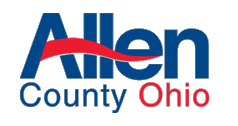
Service: Sanitary Sewer
The County Sanitary Engineer derives authority through the Ohio Revised Code Section 6117. The code allows boards of County Commissioners to establish Sanitary Engineering departments for the purpose of preserving and promoting the public health and welfare. The Sanitary Engineer is responsible for the enforcement of all rules and regulations established by the Board of County Commissioners for the construction, maintenance, protection and use of sewers and sewer improvements in the county, including the establishment and use of connections of systems.
Service: Water
Ohio Revised Code Section 6103 allows the Board of County Commissioners to acquire, construct, maintain and operate any public water supply or water works system within its county for any sewer district. The county has installed and owns approximately 50 miles of public waterlines within the county connected to the City of Lima water grid system.
Department History
Late 1924 the Board of County Commissioners hired J.H. Meyer as Sanitary Engineer to oversee the design and construction of the Lost Creek Sewer Sub-district sanitary sewer improvements. The Lost Creek Sewer Sub-district was established through petition and resolution on January 27, 1925 by the Board of County Commissioners.
On December 31, 1925 the Board of County Commissioners established the original version of the Rules and Regulations Governing the Installation and Use of Sanitary Sewers and Water Supply Improvements in Allen County, Ohio.
Records indicate from the early 50’s to late 60’s the Board of County Commissioners employed R. H. Jacob as the County’s Sewer Superintendent to operate and maintain wastewater treatment and collection systems constructed by villages and developers to treat the waste produced from the expanding development areas. The facilities were not being attended to in an acceptable manner per State Health Department requirements therefore, with the development of the Ohio Environmental Protection Agency and the Clean Water Act, the Board of County Commissioners were tasked with establishing an organizational structure to better manage the County’s wastewater infrastructure.
On May 16, 1966 the Board hired Robert Tschanz, the second Sanitary Engineer to oversee the department as we know it today. On May 8, 1967 the Board of County Commissioners consolidated all of its sewer sub-districts under one single countywide sewer sub-district. This allowed the Board of County Commissioners to control all sanitary sewer and wastewater treatment construction in the unincorporated areas of the County. On August 3, 1967 the Board of County Commissioners adopted a new set of Rules, Regulations, Procedures, and General Specifications Governing Sanitary Sewerage and Water Supply replacing the December 31, 1925 version. From 1967 through 1968 contracts were given to construct sanitary sewer collectors and treatment facilities to centralize treatment at three different locations within the County. The centralization would eliminate the “packaged treatment facilities” presently serving individual service areas and subdivisions. The three facilities constructed were: the American Bath WWTP; the Shawnee #2 WWTP; and the American #2 WWTP. The three facilities were originally constructed as temporary facilities. The plan was for all sewage in the county to be eventually tied into the City of Lima System. To date, the trend is to continue expansion of the three facilities and use them as permanent facilities.
On January 19, 1988 The Board of County Commissioners hired Henry Hollinger as Sanitary Engineer to replace retiring Robert Tschanz. On July 23, 1991 Steve Kayatin was promoted from Assistant Sanitary Engineer to Sanitary Engineer filling the vacancy resulting from the retirement of Henry Hollinger. On July 7, 2022 Brad Niemeyer was promoted from Assistant Sanitary Engineer to Sanitary Engineer.



 COPYRIGHT © 2025 Allen County Commissioners
COPYRIGHT © 2025 Allen County Commissioners